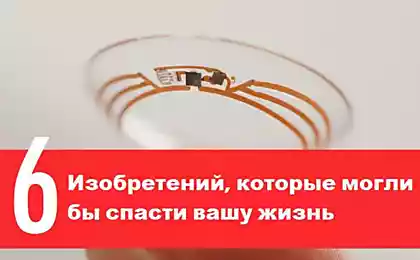440
Created a wireless pacemaker
The pacemaker can be maintained using a generator of electromagnetic waves, located just on the surface of the body.
For people with arrhythmias often the only salvation is a pacemaker or artificial pacemaker. Disorders of rate and any abnormal heart rhythm seriously affect the condition of the body and can in severe cases lead to death, so when using medications to normalize heart rhythm fails, the man put a permanent pacemaker.
This device consists of one or more electrodes connected to a source of electrical pulses. Electrodes are inserted into the heart, the source of pulses is implanted under the skin. And works the whole structure as long as the stimulator is not bullshit. After that, you will have to do minor surgery and deliver new sources of food.

Over time, pacemakers have become smaller, and the electrodes with wires, it became possible to enter into the heart via a catheter through his vein. But no matter how small a stimulant, and no matter how thin or wire, it still need to change the batteries and this means the inevitable surgery. In addition, transactions with the electrodes leading to the heart can wear out, and from time to time they also need to be changed. And the obvious question arises: is it possible to construct a wireless pacemaker, so that the source pulse can be generally placed outside the body?
On this task, thinking in the 60-ies of the last century, and, in General, the fundamental decision came rather quickly: a pacemaker can be organized as a Tesla transformer, whose one part is outside and the other in the heart. The electromagnetic field of the outer part of the device will generate an electric current in the internal "heart" part, so you can do without the wires and implanting the power source under the skin. But to implement this idea in practice failed to transmit the electromagnetic signal through the tissue inside the body, the outer portion of the device was to develop the capacity of 100 Watts – the power the patient would be burned. Obviously, needed to create a transmitter that would be safer and could transmit electromagnetic pulses into the interior of the stimulator. To solve this task was Ada POON (Ada S. Y. Poon) and her colleagues from Stanford University. According to the researchers, the idea of a Tesla transformer, in principle, was not too successful, as the electromagnetic energy from its outer portion diverging and that at least something perepalo the inner part of the stimulator, the power device must be very high. Instead, the researchers constructed a transmitter that focused the electromagnetic field in the desired direction, in the direction of intracardiac implant.
Transmitter this looks like a square plate with a side about 6 cm, which with a frequency of 1.6 GHz runs alternating current; the path of the current such that the electromagnetic wave goes directly to the intracardiac receiver. (This technology resembles that used for signal transmission in mobile communications.) The receiver is actually a stimulant, while in size it is not more than a grain of rice.
Stimulator fed by outside electromagnetic field, generates a correcting impulse in the heart. Here again, you do not need any wires, and the field generator can just keep on the breast without any operations. However, he may be much weaker devices based on the Tesla transformer.
A new stimulant, the authors tested on models of the heart and brain, and man, and then implanted the normal rabbit. A pacemaker is well controlled the frequency of contractions of rabbit heart, while the outer part does not overheat and the skin of the rabbit is not burned. As for the clinical use, according to rough estimates, such a pacemaker may be publicly available somewhere in 5-10 years.
The article in the Proceedings of the National Academy of Sciences, the researchers say that their technology can be used not only pacemakers, but also in General for a wide range of medical devices, for example cochlear implants, in which the outer microphone and the acoustic signal transmitter connected by wires to a chip in the cochlea of the ear.
However, in the case of cochlear implants, recently there was another wireless technology: in February of this year, researchers from mit announced the creation of a device that dispenses with an external microphone and transmitter, using as a source of acoustic signals in the auditory ossicles of the ear. A special microchip reads the acoustic information from the auditory ossicles and transmits the electromagnetic wave to the receiver in the inner ear. Of course, to generate electromagnetic waves, there must also be power supply, but, as the authors claim the technology to recharge this implant can be wirelessly. As for themselves, pacemakers, then there are some alternative solutions. Earlier this year in the journal Proceedings of the National Academy of Sciences published an article of researchers from the University of Illinois at Urbana and Champaign, in which they described how to get pacemaker to work from the heart – to receive energy from the heart rate, the authors used the piezoelectric effect. It again allows you to get rid of wires and generally from an external power source; in favor of this work and says that the piezoelectric implant was successfully tested on large animals, such as cows and pigs. Now just have to figure out which of the proposed technologies will be the most safe and predictable.
Source: nkj.ru
For people with arrhythmias often the only salvation is a pacemaker or artificial pacemaker. Disorders of rate and any abnormal heart rhythm seriously affect the condition of the body and can in severe cases lead to death, so when using medications to normalize heart rhythm fails, the man put a permanent pacemaker.
This device consists of one or more electrodes connected to a source of electrical pulses. Electrodes are inserted into the heart, the source of pulses is implanted under the skin. And works the whole structure as long as the stimulator is not bullshit. After that, you will have to do minor surgery and deliver new sources of food.

Over time, pacemakers have become smaller, and the electrodes with wires, it became possible to enter into the heart via a catheter through his vein. But no matter how small a stimulant, and no matter how thin or wire, it still need to change the batteries and this means the inevitable surgery. In addition, transactions with the electrodes leading to the heart can wear out, and from time to time they also need to be changed. And the obvious question arises: is it possible to construct a wireless pacemaker, so that the source pulse can be generally placed outside the body?
On this task, thinking in the 60-ies of the last century, and, in General, the fundamental decision came rather quickly: a pacemaker can be organized as a Tesla transformer, whose one part is outside and the other in the heart. The electromagnetic field of the outer part of the device will generate an electric current in the internal "heart" part, so you can do without the wires and implanting the power source under the skin. But to implement this idea in practice failed to transmit the electromagnetic signal through the tissue inside the body, the outer portion of the device was to develop the capacity of 100 Watts – the power the patient would be burned. Obviously, needed to create a transmitter that would be safer and could transmit electromagnetic pulses into the interior of the stimulator. To solve this task was Ada POON (Ada S. Y. Poon) and her colleagues from Stanford University. According to the researchers, the idea of a Tesla transformer, in principle, was not too successful, as the electromagnetic energy from its outer portion diverging and that at least something perepalo the inner part of the stimulator, the power device must be very high. Instead, the researchers constructed a transmitter that focused the electromagnetic field in the desired direction, in the direction of intracardiac implant.
Transmitter this looks like a square plate with a side about 6 cm, which with a frequency of 1.6 GHz runs alternating current; the path of the current such that the electromagnetic wave goes directly to the intracardiac receiver. (This technology resembles that used for signal transmission in mobile communications.) The receiver is actually a stimulant, while in size it is not more than a grain of rice.
Stimulator fed by outside electromagnetic field, generates a correcting impulse in the heart. Here again, you do not need any wires, and the field generator can just keep on the breast without any operations. However, he may be much weaker devices based on the Tesla transformer.
A new stimulant, the authors tested on models of the heart and brain, and man, and then implanted the normal rabbit. A pacemaker is well controlled the frequency of contractions of rabbit heart, while the outer part does not overheat and the skin of the rabbit is not burned. As for the clinical use, according to rough estimates, such a pacemaker may be publicly available somewhere in 5-10 years.
The article in the Proceedings of the National Academy of Sciences, the researchers say that their technology can be used not only pacemakers, but also in General for a wide range of medical devices, for example cochlear implants, in which the outer microphone and the acoustic signal transmitter connected by wires to a chip in the cochlea of the ear.
However, in the case of cochlear implants, recently there was another wireless technology: in February of this year, researchers from mit announced the creation of a device that dispenses with an external microphone and transmitter, using as a source of acoustic signals in the auditory ossicles of the ear. A special microchip reads the acoustic information from the auditory ossicles and transmits the electromagnetic wave to the receiver in the inner ear. Of course, to generate electromagnetic waves, there must also be power supply, but, as the authors claim the technology to recharge this implant can be wirelessly. As for themselves, pacemakers, then there are some alternative solutions. Earlier this year in the journal Proceedings of the National Academy of Sciences published an article of researchers from the University of Illinois at Urbana and Champaign, in which they described how to get pacemaker to work from the heart – to receive energy from the heart rate, the authors used the piezoelectric effect. It again allows you to get rid of wires and generally from an external power source; in favor of this work and says that the piezoelectric implant was successfully tested on large animals, such as cows and pigs. Now just have to figure out which of the proposed technologies will be the most safe and predictable.
Source: nkj.ru
Solar panels will increase biodiversity
Humpback whales in different oceans are different – the new biology






















